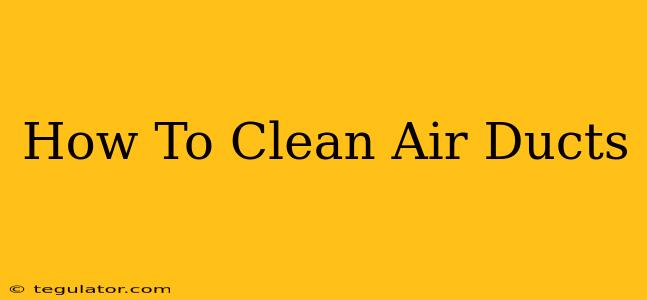Are you noticing dust, musty smells, or experiencing allergies despite regular cleaning? Your air ducts might be the culprit. Dirty air ducts circulate contaminants throughout your home, impacting indoor air quality and potentially worsening allergies and respiratory problems. This comprehensive guide will walk you through how to clean air ducts effectively, improving your home's air quality and overall health.
Why Clean Your Air Ducts?
Ignoring dirty air ducts can have significant consequences for your health and home. Here's why regular cleaning is essential:
- Improved Indoor Air Quality: Accumulated dust, dander, mold, and other allergens trapped within your ducts are constantly recirculated, compromising your indoor air quality. Cleaning removes these pollutants, creating a healthier breathing environment.
- Reduced Allergens and Irritants: For allergy sufferers, clean air ducts are crucial. Removing allergens like pet dander, dust mites, and pollen reduces allergy symptoms and improves overall comfort.
- Prevents Mold Growth: Dampness within ducts can lead to mold growth, releasing spores that trigger respiratory problems. Regular cleaning inhibits mold growth, protecting your family's health.
- Increased HVAC Efficiency: Clean ducts improve airflow, allowing your HVAC system to operate more efficiently. This can lead to lower energy bills and a longer lifespan for your system.
- Elimination of Unpleasant Odors: Musty or unpleasant odors often originate from dirty air ducts. Cleaning removes the source of these odors, leaving your home smelling fresh and clean.
How to Clean Air Ducts: A Step-by-Step Guide
While you can attempt some DIY cleaning, professional cleaning is often recommended, especially for extensive cleaning or if you suspect mold growth. However, here's what you can do for basic maintenance:
1. Preparation is Key:
- Turn off your HVAC system: Safety first! Ensure your system is completely switched off before starting any cleaning.
- Gather your supplies: You'll need a vacuum cleaner with a brush attachment, a soft-bristled brush, a flashlight, and possibly a duct cleaning kit (depending on the accessibility of your vents).
2. Cleaning the Registers (Vents):
- Remove the registers: Carefully remove the registers or vents from the walls or floors.
- Vacuum thoroughly: Use the brush attachment to vacuum all the dust and debris from the registers. Pay close attention to the crevices and edges.
- Wipe down with a damp cloth: Use a slightly damp cloth to wipe down the registers and remove any remaining residue.
- Replace the registers: Once clean and dry, carefully reinstall the registers.
3. Cleaning Accessible Ductwork (Limited DIY):
- Inspect the ducts: Use a flashlight to inspect any accessible ductwork. If you see significant buildup of dust or debris, professional cleaning is recommended.
- Vacuuming accessible areas: Use a vacuum with a long hose attachment to reach into accessible duct sections and remove loose dust and debris. This is limited to what you can easily reach.
When to Call a Professional
While some basic cleaning can be done at home, there are situations where professional air duct cleaning is absolutely necessary:
- Visible mold growth: Never attempt to clean mold yourself. Mold remediation requires specialized equipment and expertise.
- Extensive dust buildup: If you notice significant dust accumulation in your ducts, professional cleaning ensures thorough removal.
- Pest infestation: If you suspect a pest infestation in your ducts, professional cleaning and pest control are essential.
- After renovations: Renovations often disturb dust and debris, necessitating professional duct cleaning afterward.
Maintaining Clean Air Ducts
Regular maintenance is key to keeping your air ducts clean and your indoor air quality optimal:
- Regular vacuuming of vents: Vacuum your vents at least once a month, or more frequently if you have pets or allergies.
- Change air filters regularly: This prevents dust and debris from accumulating in your ducts.
- Schedule professional cleaning: Consider scheduling professional air duct cleaning every 3-5 years, or more frequently if needed.
By following these steps and understanding when to call a professional, you can significantly improve your indoor air quality and enjoy a healthier home environment. Remember, clean air ducts contribute to a healthier lifestyle, so prioritize this important home maintenance task.

